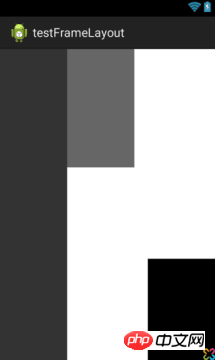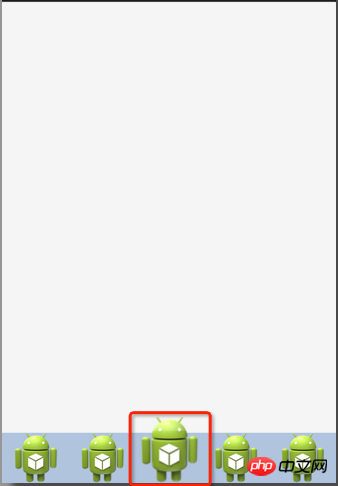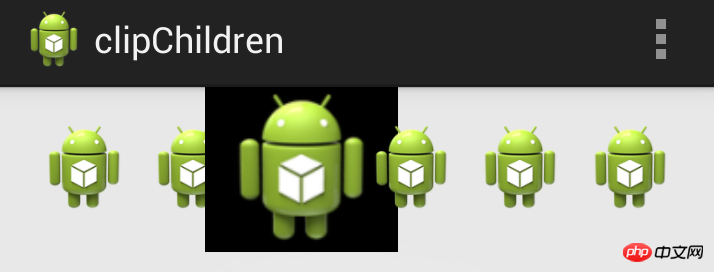Android Layout 佈局屬性全解
- 巴扎黑原創
- 2017-06-28 11:06:342956瀏覽
Android Layout 版面配置屬性全解
Android有基本 Layout:FrameLayout,LinearLayout#,TableLayout,RelativeLayout,AbsoluteLayout。
android開發者Google文件http://android.xsoftlab.net/reference/android/view/ViewGroup.html
#FrameLayout
<FrameLayout android:layout_width="" //取值范围"match_parent"、"wrap_content"、"XXdp" 布局整体宽度 android:layout_height=""//取值范围"match_parent"、"wrap_content"、"XXdp" 布局整体高度 android:layout_weight=""//取值示例"1.0" 布局所占比重 android:layout_gravity="" //取值范围"center"、"top"、"bottom"、"left"、"right"、"right|bottom" 布局位置 android:layout_margin="" //取值示例"0dp" 距离父控件四个方向距离 android:layout_marginLeft="" //取值示例"0dp" 距离父控件左间距 android:layout_marginTop="" //取值示例"0dp" 距离父控件上间距 android:layout_marginRight="" //取值示例"0dp" 距离父控件右间距 android:layout_marginBottom="" //取值示例"0dp" 距离父控件下间距 android:layout_marginStart="" //取值示例"-50dp" "50dp" 控件离父控件开始的位置的距离(前者不显示前50dp) android:layout_marginEnd="" //取值示例"-50dp" "50dp" 控件离父控件结束的位置的距离(前者不显示后50dp) android:addStatesFromChildren="" //取值范围"true" 、"false" viewgroup的drawable属性是否把它的子类的drawable的state包含进来。测试中linearlayout如果不包含该属性(false),当子widget被点击时不会出现被选中的状态。也就是子类的state不会被传递给父类了 android:descendantFocusability="" //见下 android:splitMotionEvents="" //取值范围"true" "false" 定义布局是否传递touch事件到子布局 android:layoutMode="" //取值范围 "clipBounds" "opticalBounds" 见下 android:id="" android:tag="" //listView中区别Item非常有用的Tag标签(key-value) android:scrollX="" //The initial horizontal scroll offset, in pixels. [dimension]最初的水平滚动的偏移,以像素为单位。 android:scrollY="" //The initial virtual scroll offset, in pixels. [dimension]最初的竖直滚动的偏移,以像素为单位。 android:background="" android:padding="" //取值示例"0dp" 控件内容(文本图片子控件等)距离控件四个方向边界的距离 android:paddingLeft="" android:paddingTop="" android:paddingRight="" android:paddingBottom="" android:paddingStart="" //见下 文字对齐方式详解 android:paddingEnd="" //见下 文字对齐方式详解 android:foreground="" //设置布局的前景图,前景图不会被子元素覆盖 android:foregroundGravity="" //设置布局前景图的位置 android:foregroundInsidePadding="" // android:focusable="" //取值"true" "false" 能否获得焦点(按键) android:focusableInTouchMode="" //取值"true" "false" 是否可以通过touch获取到焦点(android:focusable 为先决条件) android:fitsSystemWindows="" //取值"true" "false" 设置布局调整时是否考虑系统窗口(如状态栏) android:fadeScrollbars="" //取值"true" "false" 滚动条自动隐藏 android:fadingEdge="" //设置拉滚动条时 ,边框渐变的方向。none(边框颜色不变),horizontal(水平方向颜色变淡),vertical(垂直方向颜色变淡)。 android:fadingEdgeLength="" //滚动条渐变长度 android:filterTouchesWhenObscured="" //取值范围 "true" "false"所在窗口被其它可见窗口遮住时,是否过滤触摸事件 android:visibility="" //取值范围 "gone" "visible" "invisible"(虽不可见,但占据布局位置) android:scrollbars=""//取值范围 "none" "horizontal" "vertical" 设置滚动条 android:scrollbar //outsideInset : 该ScrollBar显示在视图(view)的边缘,增加了view的padding. 如果可能的话,该ScrollBar仅仅覆盖这个view的背景. insideInset :该ScrollBar显示在padding区域里面,增加了控件的padding区域,该ScrollBar不会和视图的内容重叠. outsideOverlay : 该ScrollBar显示在视图(view)的边缘,不增加view的padding,该ScrollBar将被半透明覆盖 insideOverlay : 该ScrollBar显示在内容区域里面,不会增加了控件的padding区域,该ScrollBar以半透明的样式覆盖在视图(view)的内容 android:isScrollContainer="" //取值范围 "true""false" 设置当前View是否为滚动容器(是否可以为输入法腾出空间而隐藏) android:scrollbarFadeDuration="" //褪色时间 android:scrollbarDefaultDelayBeforeFade="" //设置滚动条N毫秒后开始淡化,以毫秒为单位。 android:scrollbarSize="" //设置滚动条大小 android:scrollbarThumbHorizontal="@drawable" //设置水平滚动条的drawable android:scrollbarThumbVertical="@drawable" //设置垂直滚动条的drawable. android:scrollbarTrackHorizontal="@drawable"//设置水平滚动条背景(轨迹)的色drawable android:scrollbarTrackVertical="@deawable" //设置垂直滚动条背景(轨迹)的drawable注意直接 android:scrollbarAlwaysDrawHorizontalTrack="true/false" //设置水平滚动条是否含有轨道 android:scrollbarAlwaysDrawVerticalTrack="true/false" // 设置垂直滚动条是否含有轨道 android:requiresFadingEdge="none/horizontal/vertical" //定义褪色时滚动边缘 android:nextFocusLeft="@+id/" //Up键按下之后,哪一个控件获得焦点(被选中) android:nextFocusRight="@+id/" android:nextFocusUp="@+id/" android:nextFocusDown="@+id/" android:nextFocusForward="@+id/" android:clickable="true/false" android:longClickable="true/false" android:saveEnabled="true/false" //设置是否在窗口冻结时(如旋转屏幕)保存View的数据 android:drawingCacheQuality="auto|low|hight" //设置绘图缓存质量 android:keepScreenOn="true/false" //View在可见的情况下是否保持唤醒状态 android:duplicateParentState="true/false" 如果设置此属性,将直接从父容器中获取绘图状态(光标,按下等)。 注意根据目前测试情况仅仅是获取绘图状态,而没有获取事件,也就是你点一下LinearLayout时Button有被点击的效果,但是不执行点击事件。 android:minHeight="" android:minWidth="" android:soundEffectsEnabled="true/false" // 设置点击或触摸时是否有声音效果 android:hapticFeedbackEnabled="true/false" // 实现单击某个视图,系统提供一个触力反馈(震动一下) android:contentDescription="@string/" //图片不可见时的文字描述(盲人) android:onClick="" android:overScrollMode="ifContentScrolls/always/never" //滚动到边界时的效果 android:alpha="0.1" //透明度 android:translationX="" //X轴的偏移距离 android:translationY="" android:transformPivotX="" //从某点的X轴偏移距离 android:transformPivotY="" android:rotation="" //旋转 android:rotationX="" android:rotationY="" android:scaleX="" //设置X轴缩放比例 android:scaleY="" android:verticalScrollbarPosition="defaultPosition/left/right" //设置垂直滚动条的位置 android:layerType="none/hardware/software" //绘图是否开启硬件加速 android:layoutDirection="" //定义布局图纸的方向 android:textDirection="" // android:textAlignment="inherit/....." //文字对齐方式 android:importantForAccessibility="noHideDescendants/...." //设置可达性的重要行 android:accessibilityLiveRegion="" android:labelFor="" //添加标签 android:measureAllChildren="" //见下 android:animateLayoutChanges="true" //添加默认布局动画 android:clipChildren="" //见下 android:clipToPadding="" //见下转载 android:layoutAnimation="" //设置layout动画 android:animationCache="" android:persistentDrawingCache="" android:alwaysDrawnWithCache="" />
#android:descendantFocusability
開發中很常見的一個問題,專案中的listview不只是簡單的文字,常常需要自己定義listview,自己的Adapter去繼承BaseAdapter,在adapter中按照需求進行編寫,問題就出現了,可能會發生點擊每一個item的時候沒有反應,無法取得的焦點。原因多半是由於在你自己定義的Item中存在諸如ImageButton,Button,CheckBox等子控件(也可以說是Button或者Checkable的子類控件),此時這些子控件會將焦點獲取到,所以常常當點擊item時變化的是子控件,item本身的點擊沒有回應。 
android:descendantFocusability
android:descendantFocusability
android:descendantFocusability
Defines the relationship between the ViewGroup and its descendants when looking for a View to take focus.Must be one of the following constant values.
## wing constant values.
########### wing constant values.############## #######此屬性是當一個為view取得焦點時,定義viewGroup和其子控制項兩者之間的關係。 ############屬性的值有三種:############ beforeDescendants:viewgroup會優先其子類別控制項而取得焦點####### ##### afterDescendants:viewgroup只有當其子類別控制項不需要取得焦點時才取得焦點############ blocksDescendants:控制項會覆蓋子類別而直接取得焦點「而直接取得焦點」而直接取得焦點#編號########### ####通常我們用到的是第三種,也就是在Item佈局的根佈局加上android:descendantFocusability=”blocksDescendants”的屬性就好了
#android:layoutMode
Defines the layout mode of this ViewGroup.
Must be one of the following constant values.
| Constant | Value | Description |
|---|---|---|
clipBounds |
0 | Use the children's clip bounds when laying out this container.鋪設這種容器時,使用子控制項剪輯邊界。 |
opticalBounds |
1 | Use the children's optical bounds when laying out this container.鋪設這種容器時,使用子控制光纖邊界界。 |
This corresponds to the global attribute resource symbol layoutMode.
Related Methods
- ##setLayoutMode( int)
Android 4.1(Jelly Bean) 在 TextView 和 EditText 元素裡對「雙向文字順序」提供了有限的功能支持,允許應用程式在編輯和顯示字元的時候,能夠同時支援從左到右(LTR)以及從右到左(RTL)的排列格式。 Android 4.2目前已經對「從右到左」的文字排列順序給予了原生級別的全面支持,包括提供了一個佈局鏡面工具,使得開發者把能夠將優質的用戶體驗帶給每一位用戶,不管該用戶的書寫順序是從左到右,還是從右到左。
Android 4.2保證了該新特性不會影響到目前已經存在程序,如果先前的程序程式碼不修改,其應用的外觀將維持現狀。如果你想要修改程序,那麼僅僅需要很小的改動,應用就可以自動地被“鏡面反射”,這樣就能輕易地將系統語言設置為從右到左的書寫格式(阿拉伯語,希伯來語和波斯語都採用這種格式)。例如,下面的截圖展示了上述的設定效果:
從左到右的佈局方式

要實作RTL(從右到左)的佈局鏡面反射,僅僅需要遵循下列步驟就可以做到:
1. 在你的應用程式聲明文件(manifest)裡聲明開啟RTL mirroring的支持。具體做法是:在manifest.xml宣告檔案的
2. 修改應用程式中所有的「left/right」佈局屬性,改為對應的”start/end”佈局
1)如果你的應用程式是針對Android 4.2目標平台(應用的targetSdkVersion或minSdkVersion是17或更高), 那麼你就應該用「start」和「end」替換原來的「left」和「right 」。例如,android:paddingLeft應被替換為android:paddingStart。
2) 如果你想讓你的應用程式與Android 4.2之前的版本保持相容(也就是與targetSdkVersion或minSdkVersion為16或更早的版本),那麼你應當既加上「start」和“end”,又加上“left”和“right”。例如,你應同時寫上:adnroid:paddingLeft和android:paddingStart。
為了更精確地控制應用程式在UI上的文字書寫順序(從左到右,或從右到左),Android 4.2 引入瞭如下的API:
android:layoutDirection —此屬性設定元件的佈局排列方向
android:textDirection — 此屬性設定組件的文字排列方向
android:textAlignment — 該屬性設定文字的對齊方式
getLayoutDirectionFromLocale() —該方法用於獲取指定地區的慣用佈局方式
在使用從右到左的排列方式時,你甚至創建自定義的佈局方式,可繪製對象,以及其他資源。只是簡單地使用資源匹配器「ldrtl」對你的資源進行一下標識,你就可以把資源定義為「從右到左方向的資源」。在調試和優化從右到左的佈局方面,HierarchyViewer目前支援對start/end屬性,佈局方向,文字方向,文字對齊方式等所有資訊的層次化顯示。
那麼現在是時候為所有的用戶開發優美的Android應用程式了,無論用戶的文字語言習慣是從左到右,還是從右到左。我們非常期待看到這些優美應用的產生!
android:foreground
#
android:foreground 设置布局的前景图,前景图不会被子元素覆盖
android:foregroundGravity 设置布局前景图的位置
对于FrameLayout.LayoutParams,这里仅有android:layout_gravity属性,可以查看前面文章
http://isux.tencent.com/learn-android-from-zero-session3.html
我们可以实践一下:
新建一个Android项目,然后在layout文件夹找到布局xml文件并写入以下布局
运行效果如下:
android:measureAllChildren
viewFlipper中的item如何动态设置高度?
例如:
<layout_width><include></include><include></include><include></include></layout_width>
假如想做成一个layoutone是50dp,layouttwo是50dp,layoutthree是80dp高度的话,你会发现在子布局中设置高度后,ViewFlipper切换时总是以子view中高度最大的值为其高度值,也就是80dp。但是又不想让layoutone和layouttwo太高,开始的时候想通过LayoutParams动态设置吧,可惜不行(把viewflipper单独出来才行),然后找到需要设置android:measureAllChildren="false",或者代码调用setMeasureAllChildren(false);即可,因为默认情况下measureAllChildren=true。设置后各个view的高度就不同了。该属性也适合FrameLayout等。
原因:参见FrameLayout#onMeasure(int, int)的源码,android:measureAllChildren="true"时,将所有children加入到mMeasureAllChildren的链表中,然后再重新measure下。
android:clipChildren
效果图

在看到這個圖時你可以先想想如果是你,你要怎麼達成這個效果。馬上想到用RelativeLayout? NO,NO,NO,,,
#二、實作碼
xml 版本=「1.0」 編碼=「utf-8」? ##LinearLayout
xmlns:android="http://schemas.android.com/apk/res/android"# android:layout_width ="match_parent"
# android:layout_height="match_parent"
## android:clipChildren# | # ="false"
## android:orientation="垂直"
## android.support.v4.view.ViewPager
android:id#="@+id/view_pager"
## android:layout_width="match_parent"
android: : layout_weight="1.0"
#/>#
#LinearLayout android:layout_width="match_parent"
android:layout_height#="48dip"
android:background="#B0C4DE"
# android:orientation#="水平"
##ImageView android:layout_width1>>
#and#>
##andand#"1and # android:layout_height
="fill_parent"
####################################################################################################################################> android:layout_weight="1.0"
# android:scaleType=" ##="@drawable/ic_launcher"
/>
#Image
##android:layout_width="0dip"
android:layout_height="fill_parent"# android :layout_weight
="1.0"# android:scaleType
="fitCenter"## #="@drawable/ic_launcher"
/>
##o View# #android:layout_width="0dip" android:layout_height
##"64d : layout_gravity
="底部"
android:layout_weight="1.0"##> # #="fitCenter"# android:src
="@drawable/ic_launcher" />
#
ImageView android:layout_width
="0dip"android:layout_height="fill_parent"
android:layout_weight# .0 ="fitCenter"
android:src="@drawable/ic_launcher"
/> #ImageView
and android :layout_height="fill_parent"
android:layout_weight##o # ##="fitCenter" android:src
="@drawable/ic_launcher" /> ##
LinearLayout>
LinearLayout#LinearLayout>
程式碼說明:##1、只需在根節點設定android:clipChildren為false即可,預設為true
3、android:clipChildren的意思:是否限制子View在其範圍內
#翻轉文件找到下面介紹
android:clipChildren setClipChildren(boolean) Defines whether a child is limited to draw inside of its bounds or not.
android:clipToPadding setClipToPadding(boolean)Defines whether the ViewGroup will clip its drawing surface so as to exclude the padding area.
2. clipToPadding用来定义ViewGroup是否允许在padding中绘制。默认情况下,cliptopadding被设置为ture, 也就是把padding中的值都进行裁切了。1.clipChild用来定义他的子控件是否要在他应有的边界内进行绘制。 默认情况下,clipChild被设置为true。 也就是不允许进行扩展绘制。
还有该功能是android第一个版本就已经提供的方法。 所有可以跨任意android版本使用。
这两个属性联合起来能干什么呢? 哈, 用来做一些类似于心形放大等点击特效非常合适啊。 不用去更改布局, 只需加入这两个属相,并引入动画效果就完成了。
按照上面的思路,做个demo吧。
先看看最后的效果吧, 点击第三个机器人就会播放一个变大的效果(类似于心变大的效果)

废话不多说,上关键代码:
1. 布局代码(核心)
主要看设的两个关键属性android:clipChildren和android:clipToPadding均为false。 这就让点击第三个小人时,可以跨边界进行绘制,并且允许其在padding区域内绘制。
<linearlayout> <imageview></imageview> <imageview></imageview> <imageview></imageview> <imageview></imageview> <imageview></imageview> <imageview></imageview></linearlayout>
2. 其他辅助代码,如动画和act等内容

<?xml version="1.0" encoding="utf-8"?><scale></scale>

package com.example.clipchildren;import android.os.Bundle;import android.app.Activity;import android.view.Menu;import android.view.View;import android.view.animation.Animation;import android.view.animation.AnimationUtils;import android.widget.ImageView;import android.widget.Toast;public class MainActivity extends Activity { //只对第三个小人做放大动作
ImageView image3 =null;
@Override protected void onCreate(Bundle savedInstanceState) { super.onCreate(savedInstanceState);
setContentView(R.layout.activity_main);
image3 = (ImageView) findViewById(R.id.img3);
}
@Override public boolean onCreateOptionsMenu(Menu menu) { // Inflate the menu; this adds items to the action bar if it is present. getMenuInflater().inflate(R.menu.main, menu); return true;
}
public void AA(View view) {
Toast.makeText(this, "aa", Toast.LENGTH_SHORT).show();
Animation an = AnimationUtils.loadAnimation(getApplicationContext(), R.anim.anims);
image3.startAnimation(an);
}
}
3. 除了这种应用,网上还有其他人对这两个属性的妙用:
用viewPaper来实现一个Gallery效果:http://www.iteye.com/topic/1129898
以上是Android Layout 佈局屬性全解的詳細內容。更多資訊請關注PHP中文網其他相關文章!


